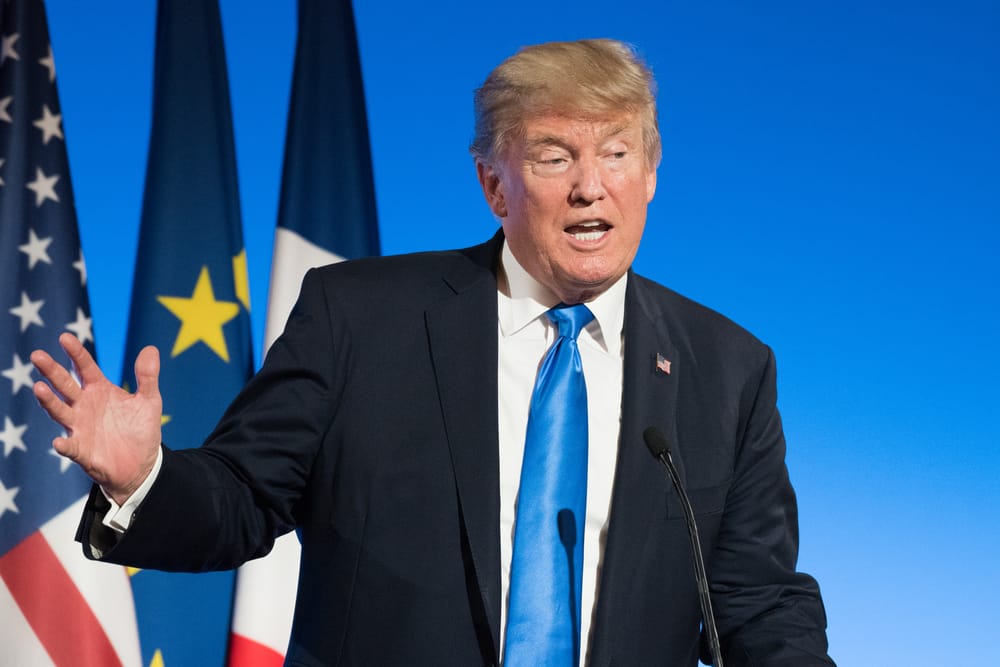- Learn more about President Donald Trump and how his policies affected stock markets and Us Dollar, and what may happen if he wins the 2020 US election.
In this article, you learn about President Donald Trump; what he accomplished in his first presidency and how it affected the USD and stock markets. We will also look at what he might focus on if he wins the 2020 presidential election, some of the arguments by the Democrats will use against him.
Born in 1946, Donald Trump became the 45th president of the United States in 2017. Before he became president, he was a well-known businessman in New York. He has been in the real estate industry for decades and currently owns some of the best-known properties in several cities in the US.
Donald Trump has always been involved in politics. He first registered as a Republican in 1987, then moved to the Reform Party in 1999, and the Democratic Party in 2001. In 1999, he formed an exploratory committee to seek the nomination of the Reform Party.
In the 2012 election, he was a vocal supporter of Mitt Romney, the then Republican candidate. After Romney lost, Trump became more involved in the Republican Party and took a more prominent position at Fox News.
In 2015, he announced that he would seek the nomination of the Republican Party. In his announcement, he talked about several issues, including illegal migration, US national debt, offshoring, and Islamic terrorism.
After the announcement, he faced-off with 16 other Republican leaders and won most states. In the national election, he faced-off with Hillary Clinton, the former first lady and secretary of state. At the election time, odds and polls were against him because of the perceived popularity of Hillary Clinton. However, he made it and was sworn in as president on March 20, 2017.
Stock performance under Trump
Before the election, the “consensus” among market participants was that Trump was bad for the economy. Furthermore, he once talked about letting the US default on its debt obligations. He also talked about deporting millions of illegal migrants, which analysts believe would be damaging for the economy.
Global stocks fell slightly after he won the election but pared those gains on the same day. That was mostly because Republicans had won both the senate and house of representative. Also, analysts started to price-in key reforms that he would implement. They were primarily excited about significant infrastructure investment, tax cuts, and deregulation. The chart below shows the performance of the Dow Jones, S&P 500, and Nasdaq under President Trump.
Stock performance under Trump
As shown above, stocks have generally been positive in the Trump administration. In his tenure, the Dow Jones, S&P 500, Nasdaq, and Russel reached their all-time highs.
The only challenge came this year due to the coronavirus pandemic and the recession that ensued. This pandemic led the leading indices to have their sharpest declines in years. For example, the Dow Jones had its worst day on record in March this year.
Key Trump economic policies
The economic agenda of Donald Trump has revolved around three things: tax reform, deregulation, and trade.
On tax reform, the president, working with congressional leaders unveiled their tax reform package in 2018. This was an important step because the president had just lost the healthcare debate when his bill failed to pass in the senate.
The tax reform was welcomed by business leaders and investors as well. This is because it lowered corporate taxes from the previous 35% to about 21%. Individuals also saw a significant tax cut, with H&R Block saying that the average person saw a tax cut of about $1,200. This is because the top rate fell from 39.6% to 37% while the previous tax bracket of 15% fell to 12%.
The goal of the president was to let companies pay their employees more money. And they did. Shortly after the bill passed, many companies announced significant bonuses to their employees. He also wanted to incentivize more companies to move back to the United States. However, very few companies did that because America’s wages are significantly higher than those in China and Mexico. Indeed, some companies like General Motors and Harley Davidson announced plant closures.
As a businessman, Trump saw the rise of regulations in the Obama administration. During the campaign, he vowed to reduce the regulatory burden in the country. According to the Brookings Institute, the administration has been relatively successful on that.
For example, among the most significant announcement by Trump was that he would leave the Paris Climate Accord. He also repealed the Clean Air Act and Clean Power Plan acts that were signed by Barrack Obama. Other regulations he has repealed are Net Neutrality, Title IX guidance on transgender student rights, and dealer markups guidance.
At the same time, he has removed some of the existing restrictions that limited coal and natural gas extraction.
After the tax reform, Trump started to focus on trade. During the campaign, he lamented about how other countries, including China, Mexico, and in Europe were taking advantage of the United States. He talked about how trade deals like the North American Free Trade Agreement (NAFTA) had led many companies like General Motors to shift their production to Mexico. He also complained about the Trans-Pacific Partnership (TPP), a trade deal that the Obama administration was negotiating. He pulled out of the accord in 2017.
In 2018, Trump started a trade war with several countries. He began by applying steel and aluminium tariffs from most countries, including allies like Canada, Mexico, Japan, and the eurozone. His goal was to incentivize most steel and aluminium smelters to come back to the US. As shown below, the three indices dropped in March.
Stocks Performance March 2018
After this, he became more targeted towards China. Between 2018 and January this year, the US and China added tariffs against one another, leading the stock market to underperform in 2018. The two countries reached the first phase of a deal in January.
Another achievement of the Trump administration was the renegotiation of NAFTA, which is now known as USMCA.
Finally, Trump has also had an impact on monetary policy. His biggest decision was to end Janet Yellen’s tenure as the Federal Reserve president. He replaced her with Jerome Powell. At the time, he hoped that Powell would lower interest rates and provide a more accommodative policy. He was wrong. The central bank increased interest rates three times in 2017 and 2 times in 2018.
The US dollar index declined from 102 to 88.85 between January 2017 and January 2018. It then started rallying, reaching a high of 101.90 this year.
US dollar index under Trump
Trump 2020 campaign policies
In the current election cycle, Trump will continue focusing on tax cuts, deregulation, and trade. On tax cuts, he has proposed making payroll tax cuts to stimulate the economy at a time when the unemployment rate has surged.
Trump will also focus on trade. While he believes that he has made some progress, he still believes that more should be done. For example, he will focus on his achievements in passing the first phase of the trade agreement with China. Still, since the first phase was relatively narrow, he will pledge to continue putting pressure on China.
Meanwhile, the US still has a large trade deficit with the eurozone. In his first term, the president has not managed to address these issues. Therefore, there is a possibility that he will talk more about the eurozone and how “unfair” it is with the United States. For example, recently, he has announced that he will reduce the number of troops stationed in Germany.
Trump will also likely focus on infrastructure spending. According to the media, the president is considering a $1 trillion infrastructure spending as part of the coronavirus rescue package. Such a package will be beneficial to many American companies. For example, a company like Caterpillar, a Dow Jones component, would see more sales of its excavators.
Trump on the defensive
All in all, in this campaign season, Trump will be on the defensive since he will need to answer key questions. For example, Democrats will say that wages did not rise after the tax cuts. They will also say that the biggest beneficiaries of the cuts were billionaires, who received billions of dollars in dividends. Also, they will point to the many companies that announced plant closures during his tenure.
Democrats will also attack him for his response to the coronavirus pandemic. They will point to the fact that the US has the most infections and most deaths. As a result, they will highlight the fact that the unemployment rate has surged to the highest point on record in his tenure.
Republicans have always been key advocates of fiscal responsiveness. However, during his administration, the budget deficit has continued to rise and the overall US debt has reached an unprecedented level of more than $26 trillion. While most of this debt has been because of the virus, they will argue that the deficit has been rising before the virus.
Also, they will argue that the trade wars were unwarranted and ineffective. For example, most people believe that the USMCA agreement was not very different from the original NAFTA. Also, they will point out that China has not implemented the first phase of the agreement.






